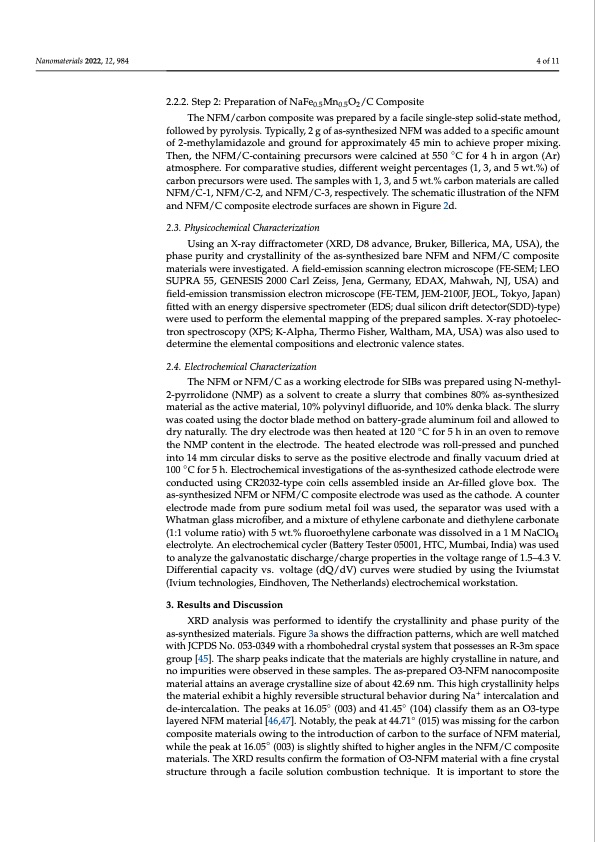
PDF Publication Title:
Text from PDF Page: 004
Nanomaterials 2022, 12, 984 4 of 11 2.2.2. Step 2: Preparation of NaFe0.5Mn0.5O2/C Composite The NFM/carbon composite was prepared by a facile single-step solid-state method, followed by pyrolysis. Typically, 2 g of as-synthesized NFM was added to a specific amount of 2-methylamidazole and ground for approximately 45 min to achieve proper mixing. Then, the NFM/C-containing precursors were calcined at 550 ◦C for 4 h in argon (Ar) atmosphere. For comparative studies, different weight percentages (1, 3, and 5 wt.%) of carbon precursors were used. The samples with 1, 3, and 5 wt.% carbon materials are called NFM/C-1, NFM/C-2, and NFM/C-3, respectively. The schematic illustration of the NFM and NFM/C composite electrode surfaces are shown in Figure 2d. 2.3. Physicochemical Characterization Using an X-ray diffractometer (XRD, D8 advance, Bruker, Billerica, MA, USA), the phase purity and crystallinity of the as-synthesized bare NFM and NFM/C composite materials were investigated. A field-emission scanning electron microscope (FE-SEM; LEO SUPRA 55, GENESIS 2000 Carl Zeiss, Jena, Germany, EDAX, Mahwah, NJ, USA) and field-emission transmission electron microscope (FE-TEM, JEM-2100F, JEOL, Tokyo, Japan) fitted with an energy dispersive spectrometer (EDS; dual silicon drift detector(SDD)-type) were used to perform the elemental mapping of the prepared samples. X-ray photoelec- tron spectroscopy (XPS; K-Alpha, Thermo Fisher, Waltham, MA, USA) was also used to determine the elemental compositions and electronic valence states. 2.4. Electrochemical Characterization The NFM or NFM/C as a working electrode for SIBs was prepared using N-methyl- 2-pyrrolidone (NMP) as a solvent to create a slurry that combines 80% as-synthesized material as the active material, 10% polyvinyl difluoride, and 10% denka black. The slurry was coated using the doctor blade method on battery-grade aluminum foil and allowed to dry naturally. The dry electrode was then heated at 120 ◦C for 5 h in an oven to remove the NMP content in the electrode. The heated electrode was roll-pressed and punched into 14 mm circular disks to serve as the positive electrode and finally vacuum dried at 100 ◦C for 5 h. Electrochemical investigations of the as-synthesized cathode electrode were conducted using CR2032-type coin cells assembled inside an Ar-filled glove box. The as-synthesized NFM or NFM/C composite electrode was used as the cathode. A counter electrode made from pure sodium metal foil was used, the separator was used with a Whatman glass microfiber, and a mixture of ethylene carbonate and diethylene carbonate (1:1 volume ratio) with 5 wt.% fluoroethylene carbonate was dissolved in a 1 M NaClO4 electrolyte. An electrochemical cycler (Battery Tester 05001, HTC, Mumbai, India) was used to analyze the galvanostatic discharge/charge properties in the voltage range of 1.5–4.3 V. Differential capacity vs. voltage (dQ/dV) curves were studied by using the Iviumstat (Ivium technologies, Eindhoven, The Netherlands) electrochemical workstation. 3. Results and Discussion XRD analysis was performed to identify the crystallinity and phase purity of the as-synthesized materials. Figure 3a shows the diffraction patterns, which are well matched with JCPDS No. 053-0349 with a rhombohedral crystal system that possesses an R-3m space group [45]. The sharp peaks indicate that the materials are highly crystalline in nature, and no impurities were observed in these samples. The as-prepared O3-NFM nanocomposite material attains an average crystalline size of about 42.69 nm. This high crystallinity helps the material exhibit a highly reversible structural behavior during Na+ intercalation and de-intercalation. The peaks at 16.05◦ (003) and 41.45◦ (104) classify them as an O3-type layered NFM material [46,47]. Notably, the peak at 44.71◦ (015) was missing for the carbon composite materials owing to the introduction of carbon to the surface of NFM material, while the peak at 16.05◦ (003) is slightly shifted to higher angles in the NFM/C composite materials. The XRD results confirm the formation of O3-NFM material with a fine crystal structure through a facile solution combustion technique. It is important to store thePDF Image | NaFe0 Nanocomposite as a Cathode for Sodium-Ion Batteries

PDF Search Title:
NaFe0 Nanocomposite as a Cathode for Sodium-Ion BatteriesOriginal File Name Searched:
nanomaterials-12-00984-v2.pdfDIY PDF Search: Google It | Yahoo | Bing
Salgenx Redox Flow Battery Technology: Salt water flow battery technology with low cost and great energy density that can be used for power storage and thermal storage. Let us de-risk your production using our license. Our aqueous flow battery is less cost than Tesla Megapack and available faster. Redox flow battery. No membrane needed like with Vanadium, or Bromine. Salgenx flow battery
| CONTACT TEL: 608-238-6001 Email: greg@salgenx.com | RSS | AMP |